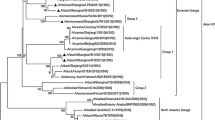Abstract
In January 2009, an H4N2 subtype of avian influenza virus [A/duck/Hunan/8-19/2009 (H4N2)] was isolated from domestic ducks in Dongting Lake wetland. The whole genome of the virus was sequenced and the results indicated that multiple gene segments of the virus had a high homology with viruses isolated from wild waterfowl, which indicated that the virus was probably transmitted from wild waterfowl to domestic ducks. Phylogenetic analysis revealed that the each gene belonged to the Eurasian lineage of avian influenza viruses, but genetic reassortment occurs between viruses of different subtypes.




Similar content being viewed by others
References
K.M. Sturm-Ramirez, D.J. Hulse-Post, E.A. Govorkova, J. Humberd, P. Seiler, P. Puthavathana, C. Buranathai, T.D. Nguyen, A. Chaisingh, H.T. Long, T.S. Naipospos, H. Chen, T.M. Ellis, Y. Guan, J.S. Peiris, R.G. Webster, Are ducks contributing to the endemicity of highly pathogenic H5N1 influenza virus in Asia? J. Virol. 79, 11269 (2005)
R.G. Webster, W.J. Bean, O.T. Gorman, T.M. Chambers, Y. Kawaoka, Evolution and ecology of influenza A viruses. Microbiol. Rev. 56, 152 (1992)
D.J. Alexander, An overview of the epidemiology of avian influenza. Vaccine 25, 5637 (2007)
R.A. Fouchier, V. Munster, A. Wallensten, T.M. Bestebroer, S. Herfst, D. Smith, G.F. Rimmelzwaan, B. Olsen, A.D. Osterhaus, Characterization of a novel influenza A virus hemagglutinin subtype (H16) obtained from black-headed gulls. J. Virol. 79, 2814 (2005)
D. Kalthoff, A. Globig, M. Beer, Highly pathogenic avian influenza as a zoonotic agent. Vet. Microbiol. 140, 237 (2010)
K.M. Butt, G.J. Smith, H. Chen, L.J. Zhang, Y.H. Leung, Xu. KM, W. Lim, R.G. Webster, K.Y. Yuen, J.S. Peiris, Y. Guan, Human infection with an avian H9N2 influenza A virus in Hong Kong in 2003. J. Clin. Microbiol. 43, 5760 (2005)
Y. Guan, K.F. Shortridge, S. Krauss, R.G. Webster, Molecular characterization of H9N2 influenza viruses: were they the donors of the “internal” genes of H5N1 viruses in Hong Kong? Proc. Natl. Acad. Sci. USA 96, 9363 (1999)
Y. Guan, K.F. Shortridge, S. Krauss, P.S. Chin, K.C. Dyrting, T.M. Ellis, R.G. Webster, M. Peiris, H9N2 influenza viruses possessing H5N1-like internal genomes continue to circulate in poultry in southeastern China. J. Virol. 74, 9372 (2000)
http://en.wikipedia.org/wiki/East_Asian_-_Australasian_Flyway. Accessed 6 June 2011
http://www.sibeflyway.org/Map-Eastern-web.html. Accessed 5 June 2011
Y. Kanai, M. Ueta, N. Germogenov, M. Nagendran, N. Mita, H. Higuchi, Migration routes and important resting areas of Siberian cranes (Grus leucogeranus) between northeastern Siberia and China as revealed by satellite tracking. Biol. Conserv. 106, 339–346 (2002)
http://www.wetlands.org/WatchRead/Allourpublications/tabid/1911/mod/1570/articleType/ArticleView/articleId/1478/Default.aspx. Accessed 8 June 2011
A.D. Fox, L. Cao, M. Barter, E.C. Reese, R.D. Hearn, C.P. Hao, W. Xin, Z. Young, D.S. Tao, S.X. Fang, The functional use of East Dongting Lake China, by wintering geese. Wildfowl 58, 3–19 (2008)
M.S. Lee, P.C. Chang, J.H. Shien, M.C. Cheng, H.K. Shieh, Identification and subtyping of avian influenza viruses by reverse transcription-PCR. J. Virol. Methods 97, 13 (2001)
E. Hoffmann, J. Stech, Y. Guan, R.G. Webster, D.R. Perez, Universal primer set for the full-length amplification of all influenza A viruses. Arch. Virol. 146, 2275 (2001)
S. Kumar, K. Tamura, M. Nei, MEGA3: integrated software for molecular evolutionary genetics analysis and sequence alignment. Brief. Bioinform. 5, 150 (2004)
A. Globig, A. Baumer, S. Revilla-Fernandez, M. Beer, E. Wodak, M. Fink, N. Greber, T.C. Harder, H. Wilking, I. Brunhart, D. Matthes, U. Kraatz, P. Strunk, W. Fiedler, S.R. Fereidouni, C. Staubach, F.J. Conraths, C. Griot, T.C. Mettenleiter, K.D. Stark, Ducks as sentinels for avian influenza in wild birds. Emerg. Infect. Dis. 15, 1633 (2009)
R.G. Webster, M. Yakhno, V.S. Hinshaw, W.J. Bean, K.G. Murti, Intestinal influenza: replication and characterization of influenza viruses in ducks. Virology 84, 268 (1978)
H. Kida, R. Yanagawa, Y. Matsuoka, Duck influenza lacking evidence of disease signs and immune response. Infect. Immun. 30, 547 (1980)
R.D. Slemons, B.C. Easterday, Virus replication in the digestive tract of ducks exposed by aerosol to type-A influenza. Avian Dis. 22, 367 (1978)
M. Gilbert, P. Chaitaweesub, T. Parakamawongsa, S. Premashthira, T. Tiensin, W. Kalpravidh, H. Wagner, J. Slingenbergh, Free-grazing ducks and highly pathogenic avian influenza, Thailand. Emerg. Infect. Dis. 12, 227 (2006)
M. Gilbert, X. Xiao, D.U. Pfeiffer, M. Epprecht, S. Boles, C. Czarnecki, P. Chaitaweesub, W. Kalpravidh, P.Q. Minh, M.J. Otte, V. Martin, J. Slingenbergh, Mapping H5N1 highly pathogenic avian influenza risk in Southeast Asia. Proc. Natl. Acad. Sci. USA 105, 4769 (2008)
M. Matrosovich, N. Zhou, Y. Kawaoka, R. Webster, The surface glycoproteins of H5 influenza viruses isolated from humans, chickens, and wild aquatic birds have distinguishable properties. J. Virol. 73, 1146 (1999)
J. Li, H. zu Dohna, N.L. Anchell, S.C. Adams, N.T. Dao, Z. Xing, C.J. Cardona, Adaptation and transmission of a duck-origin avian influenza virus in poultry species. Virus Res. 147, 40 (2010)
A.I. Karasin, I.H. Brown, S. Carman, C.W. Olsen, Isolation and characterization of H4N6 avian influenza viruses from pigs with pneumonia in Canada. J. Virol. 74, 9322 (2000)
Acknowledgments
This study was supported by the following research funds: European Union Project (SSPE-CT-2006-44405); National 973 Project (2010CB530301); National Key Technology R&D Program of China (2006BAD06A03); National Natural Science Foundation of China.
Author information
Authors and Affiliations
Corresponding author
Rights and permissions
About this article
Cite this article
Zhang, H., Chen, Q. & Chen, Z. Characterization of an H4N2 avian influenza virus isolated from domestic duck in Dongting Lake wetland in 2009. Virus Genes 44, 24–31 (2012). https://doi.org/10.1007/s11262-011-0658-9
Received:
Accepted:
Published:
Issue Date:
DOI: https://doi.org/10.1007/s11262-011-0658-9




